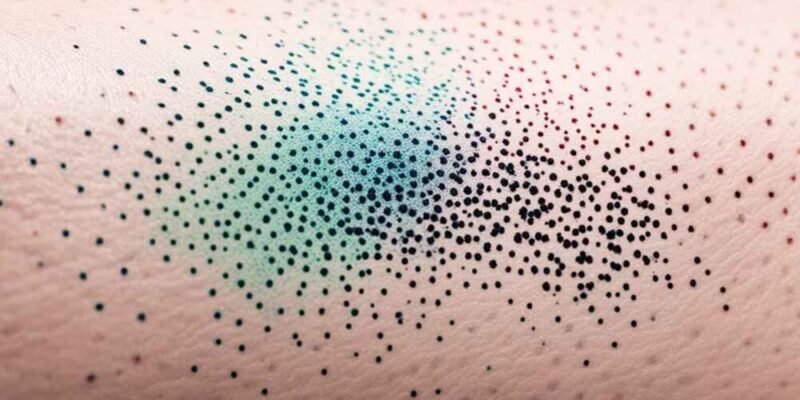Tattoos are more popular now, but sometimes people want to remove them. Luckily, laser technology has made tattoo removal safe and effective. This article will use science and technology to explain how laser tattoo removal works.
Laser tattoo removal has a long history. It started with methods like dermabrasion and chemical peels. But now, lasers have changed the game, offering a safer and more effective way to remove tattoos.
The key to laser tattoo removal is selective photothermolysis. This means the laser energy targets and breaks down the tattoo ink in the skin. The laser’s wavelength matches the tattoo color, only affecting the ink without harming the skin.
Introduction to Laser Tattoo Removal
Laser tattoo removal is a top choice for those wanting to erase unwanted tattoos. It uses light beams to break down tattoo ink on the skin. The body then gets rid of these ink particles naturally over time. Knowing how tattoo removal has changed helps us see how far it has come.
What is Laser Tattoo Removal?
This safe, modern method uses lasers to hit and break up tattoo colors. The laser’s energy is set to match the ink’s absorption, making sure it only targets the tattoo. This method has changed how tattoos are removed, making it safer and less harsh than the old ways.
The History of Tattoo Removal Techniques
Previously, removing tattoos was difficult and often painful. Old methods included surgery, skin scraping, and harsh chemicals, which were risky and didn’t work well. The 1990s brought laser technology to tattoo removal, changing everything.
Lasers can now safely and effectively target specific ink colors and depths, making laser removal the top choice for getting rid of unwanted tattoos.
Laser technology keeps improving, making treatments quicker, less painful, and more successful. Knowing about tattoo removal’s history helps people make better choices when removing tattoos.
How Does Laser Tattoo Removal Work?
Laser tattoo removal is a top-notch way to say goodbye to unwanted ink. It’s based on advanced technology. The laser targets the wavelengths that match the tattoo colors.
Understanding the Principles of Laser Technology
A laser sends out a focused beam of light that the skin’s pigment absorbs. This energy breaks down the pigment into smaller pieces, which the body’s immune system naturally removes.
The Role of Laser Wavelengths in Tattoo Removal
Each tattoo color needs a specific laser wavelength. For example, blue and green need different wavelengths than red and yellow. This precise matching helps break and remove the ink effectively.
“The key to successful laser tattoo removal is the ability to precisely target the different pigment colors with the appropriate wavelengths.”
After the laser breaks down the ink, the body starts to heal. Over several sessions, the ink pieces are removed. This method is safe and works well on even the toughest tattoos.
Tattoo Pigments and the Laser Removal Process
The success of laser tattoo removal depends on the makeup and depth of the tattoo pigments. Different inks, like organic and inorganic, react differently to laser wavelengths. Knowing these differences is critical to the best results.
Organic pigments come from plants, animals, or minerals and absorb laser energy well, making them easier to remove with lasers. Inorganic pigments are harder to remove and might need more laser power or a precise method to work.
The depth of the pigments in the skin affects removal. Deeper colors need more sessions or more robust lasers to break down. However, tattoos closer to the surface can be removed with fewer treatments.
| Tattoo Ink Type | Laser Removal Characteristics |
| Organic Pigments | Tend to absorb laser energy more efficiently, generally easier to remove |
| Inorganic Pigments | It can be more challenging, and may require higher laser fluencies or a more targeted approach |
Exploring the Different Laser Technologies Used
Laser specialists in Brisbane use various lasers for tattoo removal. Each laser targets different tattoo colors and skin types. The leading lasers are Q-switched, picosecond, and fractionated, each with benefits.
| Laser Technology | Key Features | Ideal for |
| Q-switched Lasers | These lasers emit short, high-energy pulses that can effectively break down a wide range of tattoo pigments, including professional and amateur tattoos. | Q-switched lasers are versatile and can be used on various skin types and tattoo colors, making them a popular choice for laser tattoo removal brisbane procedures. |
| Picosecond Lasers | Picosecond lasers deliver even shorter pulses, allowing for more targeted and efficient fragmentation of tattoo pigments. They are particularly effective for removing stubborn or difficult-to-treat tattoos. | Picosecond lasers are well-suited for laser tattoo removal of colorful or resistant tattoos, as well as for treating patients with darker skin tones. |
| Fractionated Lasers | These lasers use a specialized technique that creates a grid of microscopic treatment zones, allowing for faster recovery times and reduced risk of side effects. | Fractionated lasers are often used for laser technologies targeting tattoos that are challenging to remove or for patients with sensitive skin. |
Factors Affecting the Success of Laser Tattoo Removal
The success of laser tattoo removal depends on several factors. These include the tattoo ink’s makeup, its depth, and the person’s skin type and color. Knowing these factors is critical for the best results.
Tattoo Ink Composition and Depth
The ink’s type and how deep it’s in the skin matter a lot for laser removal. Some inks, like those with heavy metals, are more challenging to remove. The laser’s ability to remove the ink depends on how deep it’s injected.
Skin Type and Tone Considerations
What your skin looks like can affect how well laser tattoo removal works. Darker skin may need special laser settings or more treatments. The laser must be set just right to hit the tattoo ink without harming the skin around it.
Do Read: Best Body Contouring Machines for Different Body Areas













